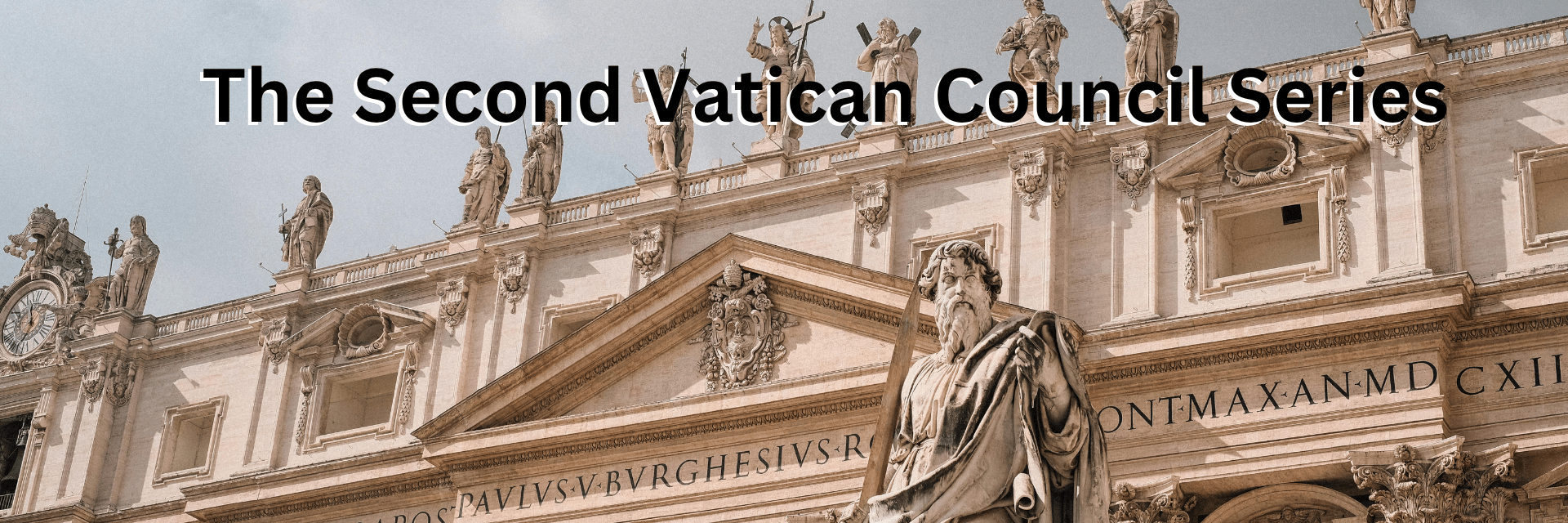8th Letter on Vatican II

VIII. A PRIMER ON SACRAMENTAL THEOLOGY REGARDING THE SACRAMENT OF HOLY ORDERS
As promised, in this letter, I am continuing the teaching to address Traditionalist concerns regarding the validity of the Sacrament of Holy Orders through the lens of Sacramental Theology. St. Thomas Aquinas addresses the sacrament of Holy Orders in his Summa Theologica, particularly in Part III, Supplement, Questions 34 to 40. These sections deal specifically with the nature of ordination, its effects, and the proper understanding of the sacrament within the Church.
The Matter and Form of Holy Orders
St. Thomas explains that, like all sacraments, the valid confering of the Sacrament of Holy Orders involves both matter and form. While he discusses ordination in the context of all three degrees of Holy Orders—bishops, priests, and deacons—the focus here will be on the ordination of priests, as this is often the center of Traditionalist concerns.
1. Matter of Holy Orders
The Church, as outlined by Aquinas, recognizes the matter of the sacrament of Holy Orders is the laying on of hands by the bishop upon a suitably chosen man without any impediments to Holy Orders. This laying on of hands symbolizes the conferral of spiritual power and authority, linking the ordained to the apostolic succession. Aquinas draws this understanding from Scripture and Tradition, particularly the New Testament accounts of ordination (e.g., 1 Timothy 4:14, 2 Timothy 1:6, Acts 6:6).
- The laying on of hands is essential because it visibly expresses the transmission of divine grace through the sacrament.
2. Form of Holy Orders
The form of the sacrament consists of the words spoken by the bishop during the ordination. According to Aquinas, these words must express the conferral of the sacramental grace and the office being bestowed upon the ordinand. The prayer that accompanies the laying on of hands is essential for the valid conferral of the sacrament.
In Aquinas’ understanding, the words of the ordination prayer must make clear that the ordinand is being set apart for the sacred ministry. For the ordination of a priest, this involves the invocation of the Holy Spirit to impart the priestly character and confer the power to celebrate the sacraments, particularly the Eucharist.
While the precise formula used in the ordination prayer has varied somewhat over time and between rites, the core meaning—that the bishop, through the imposition of hands and prayer, is conferring priestly ordination—remains constant. For Aquinas, the essential form involves the bishop’s prayer of consecration, which signifies the conferral of the sacrament and the specific office being given.
The Effects of Holy Orders
St. Thomas teaches that the sacrament of Holy Orders imprints an indelible spiritual character on the soul of the one ordained. This character cannot be repeated or lost, which is why ordination is a sacrament that can only be received once at each level (deacon, priest, or bishop).
- The sacrament confers sacramental grace, enabling the ordained minister to perform the sacred duties of his office, particularly celebrating the sacraments in the name of the Church.
- It also grants the priest the authority to act in persona Christi (in the person of Christ), especially in the celebration of the Eucharist and the forgiveness of sins through the sacrament of Penance.
Aquinas emphasizes the sacred character of ordination, which sets the ordained minister apart for divine service. This character is imparted by the Holy Spirit through the ministry of the bishop, ensuring the priest’s ability to administer the sacraments.
Intention and Validity of Ordination
In addition to the proper matter and form, Aquinas highlights the importance of intention in the sacrament of Holy Orders. The bishop who ordains must have the intention of doing what the Church does in conferring the sacrament. Similarly, the ordinand must intend to receive the sacrament and to assume the responsibilities of the priesthood.
If the proper matter (laying on of hands), form (the ordination prayer), and intention are present, the sacrament of ordination is valid. This underscores the Church’s teaching that even if the rite is modified in non-essential aspects, as long as these three elements are present, the sacrament remains valid.
Application to Traditionalist Concerns
In light of St. Thomas Aquinas’ teaching, we can address the concerns of Traditionalists regarding changes to the rite of ordination after Vatican II. While the rite of ordination was revised, the essential elements—the laying on of hands by a validly ordained bishop and the consecratory prayer that expresses the conferral of the priestly character—remain unchanged. Therefore, according to Aquinas’ sacramental theology, the changes to the surrounding prayers or ceremonial actions do not affect the validity of the sacrament. All three elements are there in the revised rite of ordination: matter, form, and intention.
Aquinas’ teaching provides reassurance that the sacrament of Holy Orders remains valid in the post-Vatican II Church, even if some aspects of the rite were modified for pastoral reasons. The essential elements of the sacrament, as defined by matter, form, and intention, are safeguarded by the Church’s authority to regulate the liturgy.
Let’s Go Deeper:
The rite of ordination underwent revisions after Vatican II as part of the broader liturgical reforms initiated by the Council. However, the essential matter (the laying on of hands) and form (the prayer of consecration) remained intact, preserving the sacrament’s validity. Let’s look at the key differences between the words of ordination before and after Vatican II.
Pre-Vatican II Rite of Ordination (Traditional Roman Rite)
Before Vatican II, the ordination of priests was conducted according to the Roman Pontifical, which had remained relatively unchanged for centuries. In this rite, the essential words for ordination, spoken by the bishop during the laying on of hands, were part of a larger, more elaborate ceremony. The key prayer that constituted the form of the sacrament had a long preface that was chanted which was interrupted and then the bishop says the following words (in Latin) which constitute the essential form of the sacrament:
Almighty Father, we pray that you bestow on these servants of yours the dignity of the priesthood. Renew in their hearts the spirit of holiness, so that they may be steadfast in this second degree of the priestly office received from you, O God, and by their own lives suggest a rule of life to others. (Taken from the 1964 rite of ordination which is the same as the 1962 rite).
This prayer, part of the larger ordination liturgy, invoked the Holy Spirit and asked for the specific grace to confer the priesthood. It was followed by the anointing of the hands with chrism and other prayers that reinforced the identity and mission of the priest.
Post-Vatican II Rite of Ordination (1970 Roman Pontifical)
After Vatican II, the ordination rite was revised in accordance with the guidelines laid out in Sacrosanctum Concilium, the Constitution on the Sacred Liturgy. The revised Roman Pontifical, promulgated by Pope Paul VI in 1968 and implemented in 1970, introduced a more streamlined form, with the goal of greater simplicity and clarity. It was later further adapted by Pope John Paul II in 1990.
In the post-Vatican II rite, the essential prayer for ordination (the prayer of consecration) is as follows:
Grant, we pray, Almighty Father, to these, your servants, the dignity of the priesthood; renew deep within them the Spirit of Holiness; may they henceforth possess the office which comes from you, O God, and is next in rank to the office of Bishop; and by the example of the manner of life may they instill right conduct. May they be worthy co-workers with our Order, so that by their preaching and through the grace of the Holy Spirit the words of the Gospel may bear fruit in human hearts and reach even to the ends of the earth. (Taken from 2nd Typical edition, Rites of Ordination of a Bishop, of Priests, and of Deacons).
This form retains the core elements of the pre-Vatican II prayer, invoking the Holy Spirit and asking for the grace to confer the priesthood. It also was followed by the anointing of the hands with chrism and other prayers that reinforced the identity and mission of the priest.
The changes introduced after Vatican II include:
- Addition of an ecclesial emphasis: The revisions reinforced the idea that the ordained ministry is exercised in communion with the bishop and the presbyterate, highlighting the collaborative nature of the priesthood. This was in line with the teachings of the Second Vatican Council, which emphasized the communal dimension of the Church's mission.
Key Differences
1. Language and Structure: The language of the post-Vatican II rite is simpler and more direct and in the vernacular, reflecting the Council’s goal of greater pastoral clarity. The older form was in Latin and was more elaborate and formal.
2. Ecclesiological Focus: The revised prayer places greater emphasis on the priest’s role in the community and in collaboration with the bishop. While both forms emphasize the priest’s sacred office, the post-Vatican II form includes a more explicit reference to the priest’s function within the hierarchical structure of the Church.
3. General Tone: The post-Vatican II prayer reflects a more contemporary and simplified theological expression, whereas the pre-Vatican II prayer had a more formal tone, in line with the traditional Latin liturgical language.
Continuity in Essentials
Despite these differences, the essential elements of the ordination rite—the laying on of hands and the invocation of the Holy Spirit in the consecratory prayer—are preserved in both the pre- and post-Vatican II rites. The revisions made to the words of ordination after Vatican II did not affect the validity of the sacrament, as the form continues to convey the necessary theological meaning: the conferral of the priestly character and the grace to carry out priestly ministry.
Conclusion
St. Thomas Aquinas' sacramental theology affirms the integrity of Holy Orders, with the proper matter (laying on of hands) and form (the prayer of consecration) being essential for the validity of the sacrament. His teachings provide a foundation for addressing concerns about post-Vatican II ordination rites, emphasizing that as long as these essential elements are preserved, the sacrament remains valid. Even if some aspects of the liturgical rites were modified, the essential nature of the sacrament, as instituted by Christ and safeguarded by the Church, remains intact.
While the words for ordination before and after Vatican II differ in their language and tone, the essential structure of the sacrament remains the same. The changes introduced by the post-Vatican II reforms simplified the rite and placed a greater emphasis on the priest’s relationship with the bishop and the ecclesial community. However, these changes do not alter the sacrament's validity, as the essential matter (the laying on of hands) and form (the consecratory prayer) remain intact.





